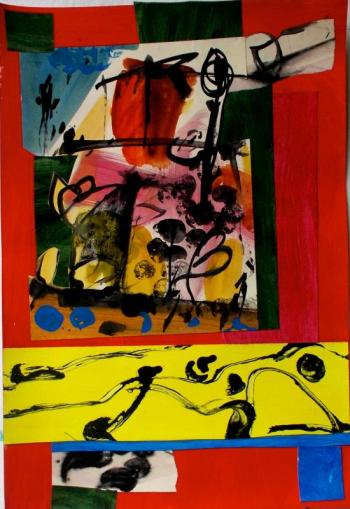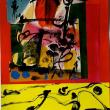Pieces of a puzzle: New works by John Vander
Coastal Maine has inspired artists for a few hundred years; Tuscany has inspired artists for a few thousand. Take an artist who spends half his time in Boothbay Harbor, Maine and the other half in Lucca, Italy, that's a lot of stimulation.
But artists are not only influenced by their surroundings and culture, they have lives just like non-artists. They make choices, take chances, make adjustments, settle in, settle down. Nonetheless, not every artist creates the opportunity for his life and his art to live in two of the most beautiful places on earth, but John Vander has.
On the one hand, he's got the sea, the fishy, salted air; volatile weather bringing crashing gray rains or crispy, golden sun shining on huge marbleized rocks. Then he's got the craggy Apennines that watch over the valleys of green and orange farms; old weathered buildings with pink and cream stucco walls; religious icons; olive branches and grape vines.
Sure, all of this impacts Vander, but his heroes come from elsewhere: Henri Matisse, and abstract expressionists Jackson Pollock and Robert Motherwell. He borrows structure and a love of color from the Frenchman, improvisation and gesture from the Americans.
Vander's new body of work took a journey, which began in Maine and ended in Italy this past year. He began in Maine by painting frames, that are washed in green, red, pink and yellow, the hand of the artist already made apparent. This was the reverse of what artists normally do, make the frame after the painting is completed. In this scenario, the frame functioned as a controlling mechanism, because the artist was required to work within the perimeters of it.
Still, what to do with all that empty space? Well, Vander had a plan.
In advance of his trip to Italy, he created pieces of colored and drawn sheets of paper in varying shapes, that he would later move around on the support like a jigsaw puzzle. The collages owe a debt to Arshile Gorky, whose own debt was to cubism, especially Gorky's Nighttime works of the 1930s. Like Gorky, each component in Vander's collages has a life of its own like a character in a play. Without the other players, however, the plot falls apart. Instead, these image achieve their resolution with all the parts coming together in a seamless whole.
Clearly, the artist had loads of fun creating these works. As a result of all that joy, the viewer gets something as well, eye candy. The vivid push and pull of colored shapes, some of which contain linear arabesques and lots of lines, this way and that, moving here, moving there, add to a delicious mix of line and color, opaque and washed, non-objective and figurative, all of this within a small scale. Vander's paintings are often large in scale, and here he's managed to incorporate much of the same energy within the confines of 30 by 24-inch rectangles.
Spending the first winter in a new home and making art in a custom-made studio that the artist and his wife, Karen (a jewelry designer), imagined into a stupendous space, twice the size of his former studio in Italy, with light pouring in from enormous windows and views of the mountains and garden, was a boon for Vander this past winter.
The rain pouring down and the cold wind blowing outside may have contributed to Vander's inner need for light and landscape that ended up in his collages. He's not a plein air painter, obviously, because these images are visuals of the mind and spirit. The safe haven of the studio was time well spent, but lest not forget, John Vander was prepared for what was at stake.
Instead of facing a blank canvas, he had all the parts; all he had to do was put them together.
Event Date
Address
41 Commercial Street
Boothbay Harbor, ME 04538
United States
























